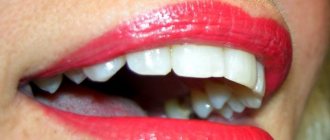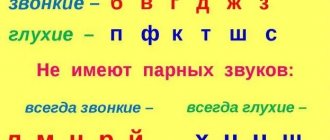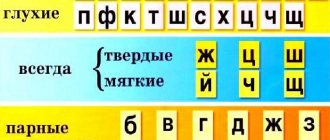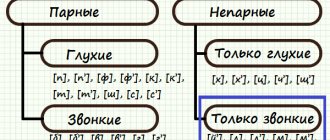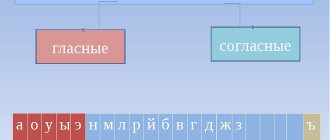Types of vowels (as taught at school)
At school, these sounds are divided into two large groups:
- Shocks - the stress falls on them in the word, so it’s easy to determine the shock sound by pronunciation: saber, pillow, bird - A, U, And in these words there are shocks.
- Unstressed - all other vowel words, the stress does not fall on them. For example, in the word box the first O and the last A are unstressed.
When we stress a vowel, we pronounce it for a long time. Longer than all other sounds. Therefore, the drums are heard very clearly and do not cause difficulties in writing. Except when they are found after sibilants and c.
But with unstressed ones everything is more complicated. Because they are not stressed, we shorten them and even change them. And then we can’t understand what letter to write. A spelling appears.
Read a separate article about unstressed vowels, everything is described there in detail, tips are given on how to easily and quickly understand all spelling rules.
Soon I will post a selection of the best courses for preparing for the Unified State Exam and preparing for the Unified State Exam. Among them there will be paid and free programs, reviews of discounts and special offers. Subscribe to updates - I will send you an email as soon as the article is published.
Vowel sounds and syllables
An important feature of a vowel sound is its ability to form a syllable. Alone or together with one or more consonants, a vowel sound makes up a syllable.
We pronounce it without immediately exhaling the entire stream of air, but releasing it in small portions, in three points. The vowel sound is the main sound in each sound segment of a word, which is called a syllable.
Conclusion: Vowel sounds form syllables in a word.
Let's count the number of vowels and syllables in the word "garden". Three vowel sounds form the same number of syllables.
Rule: There are as many syllables in a word as there are vowel sounds.
Rule!
There are as many syllables in a word as there are vowel sounds.
We can verify this if we pronounce and divide the words into syllables according to the number of vowels:
- bark
- sa-ra-fan
- dog
- u-chi-tel-ni-tsa
So, vowel sounds can be distinguished from consonants by three main features:
- consist of voice;
- during their formation, air passes freely through the organs of speech;
- form a syllable.
University classification – for Olympiad participants and future linguists
At universities, vowels are classified differently: by rows, rise, labialization. You need to know the university classification if you want to participate in Russian Olympiads, become a linguist/philologist in the future, or if you need to learn English or another foreign language from scratch.
Vowels can be front, middle or back. It depends on the position of the tongue. When we pronounce I or E, the tongue is slightly pushed forward - they belong to the front row. When we pronounce A or Y, the tongue is approximately in the middle of the oral cavity - A and Y belong to the middle row. To pronounce O and U we “push” the tongue towards the larynx, so they belong to the back row.
However, when pronouncing vowels, we not only “pull out” and “retract” our tongue, we also raise it or lower it. The tongue is raised most strongly when U, I, Y are pronounced - they refer to the upper rise. To pronounce O, E you need to lower your tongue a little - they have a medium rise. But when pronouncing A, the tongue and jaw are generally at the very bottom - this is a low vowel.
When we pronounce O and U, our lips tense. Moreover, in the case of U, it is stronger, we even pull them out into a tube. Because of this, O and U belong to labialized sounds - those in the formation of which the lips are involved. When A, I, E, Y are pronounced, the lips are almost not involved, therefore these sounds are non-labialized.
Here is a table that I remember very well from phonetics workshops in my first year at the Faculty of Philology:
However, in linguistics, in addition to the front, middle and back rows, the first and second rows are also distinguished.
Vowels of the first row indicate the hardness of the preceding consonant, just like a hard sign. These include: A, U, O, Y, E. When we see letter combinations with them, we understand that we must read without softness: RAT, SCOOP, SAVE.
Sounds of the second row: E, Yo, Yu, Ya, I. They indicate the softness of the preceding consonant: SKY, AUNT, Nanny, THREAD, NURNY.
Try pronouncing different sounds and observe the articulation. It will come in handy when working on pronunciation of words in foreign languages.
Attention. All of the above applies to stressed vowels. Unstressed words, their pronunciation and types will be discussed in a separate article.
Do you need a collection that contains all the theory in Russian - to prepare for the Unified State Exam, State Examination, or simply to systematize knowledge? I found these four manuals on the Internet; in my opinion, they are ideal options. All the material is there, there are many tables, the main thing is highlighted in underlined/bold - it is very easy to understand.
- E. S. Simakova. Russian language. A new complete guide for preparing for the Unified State Exam.
- Geraskina V.I. Collection of educational and reference materials for preparing for the Unified State Exam in the Russian language (Saransk).
- Chmir O. B. MATERIALS FOR THE USE - 2019. Reference material on the Russian language (Aldan).
- Nesterova S. L. Handbook for preparing for the State Examination in the Russian language (Sovetsky settlement, Vyborg district, Leningrad region).
It will be useful for both students and teachers. Write your email address here, I will send you all 4 manuals in one archive immediately. The files have been checked and there are no viruses.
Emails sometimes go to spam - check. If the letter hasn’t arrived at all, write a comment and I’ll sort it out.
Stressed and unstressed vowel sounds
There are strong and weak vowel positions. They correspond to their stressed and unstressed positions.
The clear pronunciation of a stressed vowel is contrasted with the reduction of unstressed vowels. In a weak position, articulation is less distinct, the duration and quality of sound is reduced.
REFERENCE! This is associated with errors in the spelling of unstressed vowels in words. For example, in the word “street”, [and] is unstressed and is heard as something between [and] and [e].
Thus, in Russian, the strong position of vowel sounds makes the differences between them more obvious.
dog
In the second syllable, the vowel sound indicated by the letter “a” sounds with particular strength and duration.
It is in a strong position and sounds clear and crisp. This vowel sound is stressed.
- peaceful
- city
- smile
- drawing
Yotated vowel sounds
Six vowel sounds correspond to 10 vowel letters of the Russian alphabet, 4 of which are formed by a pair with a consonant [y'] - ya [y'a], e [y'e], yo [y'o], yu [y'u]. In syllables and words, these iotated letters indicate the corresponding vowel sound coming after a soft consonant: forest [l'es], ball [m'ach'], and so on.
How to make money if you know Russian
If you are ok with spelling and punctuation (or generally ok, despite minor shortcomings), you can make money on the Internet from texts.
At first, the income will be small - 40-60 rubles. per page, but gradually you will find your niche and earn at least 200-400 rubles. per page. This is really true, because I myself have walked this path, from text exchanges where they pay pennies to individual cooperation with webmasters.
If you don’t know where to start, come to the “Copywriting from Scratch” course, which we created with Vasily Blinov. We will tell you in simple words what copywriting is in principle, how to correctly write articles on the Internet, how to do optimization, and carry out semantic analysis of texts.
The course includes five practices - you will write articles for the websites vsvoemdome.ru and iklife.ru. We pay for each practice. Students who complete the course pay back half of its cost and have 5 texts in their portfolio published on thousands of blogs.
Sign up for the course “Copywriting from scratch”
Russian alphabet
- A a a
- B b b b b
- In in ve
- G g g
- D d d e
- E e e
- Yo yo yo
- Zhe zhe
- Z ze ze
- And and and
- Thy and short
- K k ka
- L l el
- Mm um
- N n en
- Ooo
- P p pe
- R r er
- S s es
- T t teh
- U u u
- F f ef
- X x ha
- Ts ts tses
- Ch h wh
- Sh sh sha
- Shch shcha
- ъ hard sign
- s s
- b soft sign
- Uh uh
- Yu yu yu
- I I I
| 33 letters | ||
| 10 vowels | 21 consonants | 2 characters |
| a e e and o u y e y i | b c d g g h j j k l m n p r s t f x c h w sch | b b |
| 42 sounds | |||||
| 6 vowels | 36 consonants | ||||
| [a] [i] [o] [y] [s] [e] | Doubles | Unpaired | |||
| Drums | Unstressed | Voiced | Deaf | Voiced | Deaf |
| [b] [b'] [c] [c'] [d] [d'] [e] [d'] [g] [h] [h'] | [p] [p'] [f] [f'] [k] [k'] [t] [t'] [w] [s] [s'] | [th'] [l] [l'] [m] [m'] [n] [n'] [r] [r'] | [x] [x'] [ts] [h'] [w'] | ||
| Doubles | Unpaired | ||||
| Solid | Soft | Solid | Soft | ||
| [b] [c] [d] [e] [h] [j] [l] [m] [n] [p] [r] [s] [t] [f] [x] | [b'] [c'] [g'] [d'] [z'] [k'] [l'] [m'] [n'] [p'] [p'] [s'] [t '] [f'] [x'] | [f] [c] [w] | [th'] [h'] [h'] | ||
How do letters differ from sounds?
Sound is elastic vibrations in any medium. We hear sounds and can create them, among other things, with the help of the speech apparatus (lips, tongue, etc.).
A letter is a symbol of the alphabet. It has a capital (excl., ь and ъ) and lowercase version. Often a letter is a graphic representation of the corresponding speech sound. We see and write letters. To ensure that the writing is not affected by the peculiarities of pronunciation, spelling rules have been developed that determine which letters should be used in the word in question. The exact pronunciation of a word can be found in the phonetic transcription of the word, which is shown in square brackets in dictionaries.
The letter "s" and its cancellation
The sound "y" is a vowel. It causes misunderstanding on the part of foreigners who want to learn Russian. Over the course of a long period of learning, they do not understand how to pronounce a given sound. Phonologists characterize it as an unrounded high middle vowel. This sound is found in many languages of the world.
The sound “y” is common among the Mongols and Turkic peoples. The sound-sense differences between the letters “s” and “i” make it possible to create a new series of words and concepts.
Two years ago, Vladimir Zhirinovsky made a proposal to remove the letter “y” from the Russian language. He claims that it is not present in any European language. And not only foreigners, but also children cannot pronounce it. Experts say that it is possible to get rid of letters and sounds, but this will only create problems in spoken and written speech.
Some experts argue that it is impossible to interfere with the phonetic development of a language. The sound composition has been formed independently over many centuries, and the language itself determines it.
Over the years, consonant and vowel sounds have been formed. The classification of vowel sounds, consonants, as well as the ways of their development are described in many scientific works of philologists.
The best books for studying phonetics of the Russian language
The classification of vowels and consonants plays an important role in learning the Russian language. It is important to use additional literature when studying. This is no coincidence, because in order to study phonetics in full, a large amount of time and effort is needed. Without the use of specialized literature, high-quality training is impossible. Our article lists the best books that present the classification of vowels and consonants.
The book “Phonetics of the Modern Russian Language,” the author of which is L. L. Bulanin, combines the experience of describing the Russian language on the basis of general linguistic and phonetic ideas of the school of L. V. Shcherba. This publication is a textbook for philology students. The book presents a theoretical course of the Russian language. It contains nine chapters.
"Russian language. Phonetics. Morphology. Spelling" is one of the best teaching aids. The author of the book is A.I. Moiseev. It contains 254 pages of theoretical material. The book describes not only the classification of speech sounds (vowels, consonants), but also the basis of morphology and spelling. The purpose of the textbook is to deepen the professional knowledge of Russian language teachers and philology students.
The book “Historical Phonetics of the Russian Language” was published in 1980. Its author is V.V. Kolesov. The book contains 214 pages. It describes the development of the phonetic system of the Russian language. The author pays special attention to all-Russian language processes. All information provided in the book is supported by factual material from various sources.
“Phonetics of the Modern Russian Language” is a book authored by G. N. Girzheva. It was published a year ago. The purpose of the textbook is to develop in students an idea of the sound system of language activity, as well as to form a concept of sound units.
Many linguists have been studying speech sounds for many years. Classifying vowel sounds, as well as consonants, is quite painstaking work. To familiarize yourself with the full amount of information, it is important to use additional literature.
Phonetics and linguistics. general information
Linguistics (linguistics) is a science that studies a particular language, as well as its functions, internal structure and patterns of its functioning. Linguistics is closely related to many other areas of life and plays an important role in everyone’s life. Linguistics is intertwined with history, archaeology, ethnography, literary studies, psychology, physiology, anthropology, as well as philosophy.
Phonetics studies letters. The classification of vowels and consonants is presented in this section of science. Phonetics, as a part of linguistics, also studies syllables, sound combinations and patterns of their connection. This science was formed in the 17th century. Its creation was related to the need to educate the deaf and dumb. In the 18th century, the beginning of the acoustic theory of vowels was laid.


